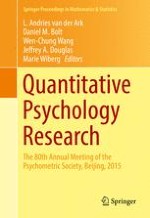2016 | OriginalPaper | Buchkapitel
A Three-Parameter Speeded Item Response Model: Estimation and Application
verfasst von : Joyce Chang, Henghsiu Tsai, Ya-Hui Su, Edward M. H. Lin
Erschienen in: Quantitative Psychology Research
Aktivieren Sie unsere intelligente Suche, um passende Fachinhalte oder Patente zu finden.
Wählen Sie Textabschnitte aus um mit Künstlicher Intelligenz passenden Patente zu finden. powered by
Markieren Sie Textabschnitte, um KI-gestützt weitere passende Inhalte zu finden. powered by
